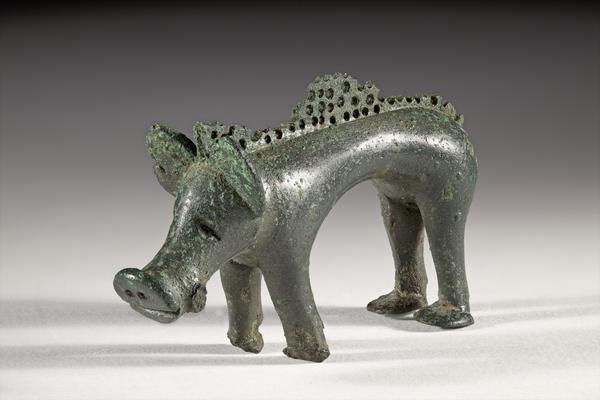boar
Accession Number NWHCM : 2011.311
Description
The Ashmanhaugh boar figurine is a three-dimensional stylised representation made of copper alloy. It is in good condition with little corrosion, although it is damaged in several places and details, such as tusks, upper crest and front feet, are missing. It has an elongated snout with flattened muzzle and a simple horizontal straight mouth. The tusks are broken away from either side and are missing. The body of the figurine narrows towards the waist. The feet are flattened and point forward, but not cast in the shape of hooves; the front two have been broken off. Their form and angle to the ground suggests that the figurine originally stood on something curved. A perforated crest runs the whole length of the back, from the top of the head, with many tiny, closely-spaced, holes, which have caused a weakness and it has broken off along its entire length. The boar’s large ears point forward. The first of two deliberate unexplained features in the casting is on the right shoulder, a symbol in the shape of a ‘tick’ mark with no possible function. The right ear carries the second deliberate unexplained casting feature, a clear semi-circular notch. This again has no possible function and must be symbolic.It measures 87mm from the tip of the snout to the rear of the spinal crest. Its widest point is 23mm, measuring from ear to ear. The maximum height is 51mm. Late Iron Age, early Romano-British
Read Moreboar
This beautiful cast bronze figurine was found at Ashmanhaugh, to the north-east of Norwich, in 1997. It is a stylised representation of a boar, and a striking addition to the growing zoo of known animal representations within the material culture of Norfolk’s Iron Age.
The boar depicted here is a stylised creature with detailed casting of its features, including the perforated crest along its back. The tusks and front feet are missing but otherwise it is in very good condition. Animals inspired much of the art of the Iron Age tribes of Britain, creating a “Celtic Zoo” from which we can try to uncover the relationships between past people and animals. Boars, along with bulls, birds and other creatures, feature strongly. Boars were symbols of strength, and they also feature as designs on Iceni coinage, along with wolves and horses. As a symbol of strength, boars were considered an appropriate symbol to adorn weaponry and armour. This figurine may have been attached to the helmet of a warrior.
Less than thirty such boar figurines are known nationally, with a further twenty or so recorded from continental Europe. They can be separated into either stylised, as depicted here, or more realistic examples. Some are known to have come from temple contexts, such as those from Hounslow. The suggestion of a religious association with boars may be reinforced by the observation that selected pig bones were sometimes carefully separated and deposited in unusual ways, at sites including Llanmaes,(south Wales) and Hallaton (Leicestershire).
The prominence of the boar on the Iron Age coinage of this part of Britain, together with this figurine, may signify that the creature had a particular significance in northern East Anglia.












